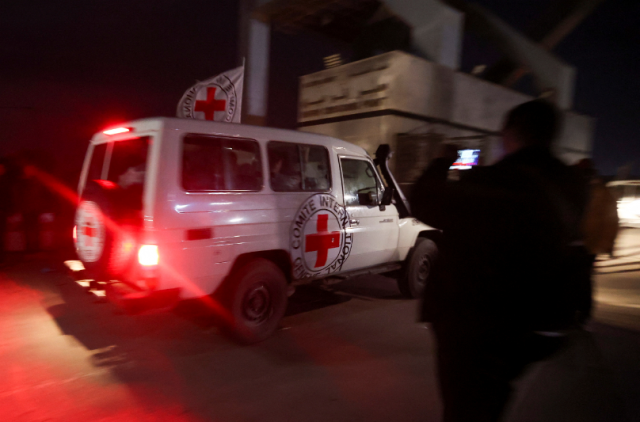
GAZA/JERUSALEM — Hamas and Israel were expected to release more hostages and prisoners on Wednesday, the last day of a prolonged six-day truce in the Gaza Strip conflict, as attention focused on whether mediator Qatar could negotiate another extension.
The Palestinian militant group Hamas and allied group Islamic Jihad freed 12 hostages on Tuesday, bringing the total released since the truce began on Friday to 81. Those have been mostly Israeli women and children along with foreign citizens.
After they were handed over by the International Committee of the Red Cross (ICRC), the Israeli military said Tuesday’s freed hostages, comprising 10 Israeli women and two Thai citizens, received initial medical checks. They then moved to Israeli hospitals where they were to meet their families. The hostages were aged 17 to 84 and included a mother-daughter pair.
A short time later, Israel released 30 Palestinians from Ofer Prison in the occupied West Bank and a Jerusalem detention center. The Palestinian Prisoner’s Club, a semi-official organization, said half were women and the remainder were teenage males. That brought the total number of Palestinians released under the truce to 180.
Israel has said the truce could be prolonged further, provided Hamas continues to free at least 10 Israeli hostages per day. But with fewer women and children still in captivity, keeping the guns quiet beyond Wednesday may require negotiating to free at least some Israeli men for the first time.
The hostages were among some 240 people seized by Hamas gunmen during a rampage into southern Israel on Oct. 7 in which Israel says 1,200 people were killed. Israel’s bombardment of Hamas-ruled Gaza in retaliation has killed more than 15,000 Gazans, health authorities there said.
Qatar, which mediated indirect talks between Hamas and Israel that resulted in the ceasefire, on Tuesday hosted the spy chiefs from Israel’s Mossad and the United States’ CIA.
The meeting sought to “build on the progress of the extended humanitarian pause agreement and to initiate further discussions about the next phase of a potential deal”, a source briefed on the visits told Reuters.
Separately, foreign ministers of the Group of Seven nations on Tuesday called in a joint statement for an extension of the ceasefire and more humanitarian aid.
About 159 hostages remain in Gaza. The White House said on Tuesday this includes eight to nine Americans. U.S. national security spokesperson John Kirby said the U.S. was hopeful that Hamas would release more Americans, and the U.S. government would work with Qatar to extend the pause in fighting.
“We want to see all the hostages out. The way to do that is these pauses,” Kirby told reporters traveling on the president’s plane on Tuesday.
Warning of more deaths due to disease in Gaza
The truce has brought Gaza its first respite after seven weeks of fighting and bombardment that has reduced much of the seaside enclave to rubble. It had been due to expire overnight into Tuesday, but both sides agreed to extend the pause to allow for the release of more Israeli hostages and Palestinian prisoners held by Israel.
Israel’s siege has led to the collapse of Gaza‘s health care system, especially in the north where no hospitals remain functioning. The World Health Organization said more Gazans could soon be dying of disease than from bombing and many had no access to medicines, vaccines, safe water and hygiene and no food.
More than two-thirds of Gaza‘s 2.3 million people have lost their homes to Israeli bombardments, with thousands of families sleeping rough in makeshift shelters with only the belongings they could carry. They are desperately short of food, fuel and clean water.
“We have a dramatic humanitarian situation. At the same time, we want to have the full release of all hostages, that we believe should be unconditional and immediate. But we need a humanitarian ceasefire in Gaza now,” U.N. Secretary-General Antonio Guterres told reporters on Tuesday.
The temporary ceasefire has allowed about 800 aid trucks to enter Gaza, and the first of three U.S. planes with humanitarian supplies for Gaza landed in Egypt on Tuesday.
U.N. aid chief Martin Griffiths was to travel to the Jordanian capital Amman on Wednesday to discuss opening the Kerem Shalom crossing to allow for humanitarian aid to enter Gaza from Israel.
Located at the intersection of Israel, the Gaza Strip and Egypt, the Kerem Shalom crossing transported more than 60% of the aid going into Gaza before the current conflict.
Aid for Gaza now comes through the Rafah crossing on the Egyptian border, which was designed for pedestrian crossings and not trucks.
“We know that more humanitarian aid should be delivered in Gaza. We know how we could increase it, but there are constraints beyond our control,” Griffiths told a briefing of member states at the United Nations in Geneva on Tuesday.
“We know that the people of Gaza need much more from us.”
When the war resumes, Israel has said it intends to press on with its assault from the northern half of Gaza into the south. The White House said on Tuesday that Israel faced an “added burden” to protect civilians in the south because many had fled from the north to the south.
– Reporting by Nidal al-Mughrabi in Cairo, Mohammed Salem and Roleen Tafakji in Gaza, Henriette Chacar and Dan Williams in Jerusalem, Ali Sawafta in Ramallah, Steve Holland on Air Force One and Reuters bureaux; Writing by Cynthia Osterman; Editing by Lisa Shumaker









